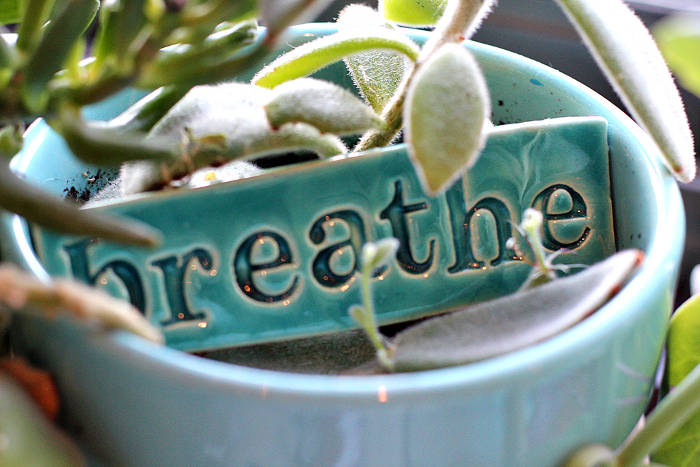What becomes possible when you learn how to “just breathe”?
My first understanding that my breath wasn’t an automatic, mindless action came when I was just 12. I was a pretty typical kid but I was always asking to do lessons in activities that were, shall we say, unusual. Bagpipes, anyone? My mother saw things like ballet and music as more natural choices. But she let me do my thing graciously. It started me on the road to learning how to “just breathe”.
Meeting Mr. Yogi
A friend was doing a meditation class with her mother and they invited me along. I thought it sounded interesting. This was in the early-ish 1970s and the Beatles had introduced the world to transcendental meditation. Our teacher looked very much like the Maharishi Mahesh Yogi, but of course it wouldn’t have been. The Maharishi had started working on some big plans and surely wasn’t teaching a small group of students in small town Ontario.
We gathered in a grade two classroom at a small elementary school. We sat in those school desks with the plastic seats and the curved arms. They were small for my friend and I and they were tiny for the adults. All of us oversized students, shifting uncomfortably, waiting for Mr. Yogi to share his secrets.
When All Else Fails, Just Breathe
He told us to focus on our breath, to breathe in and out quietly and listen to the sounds it made. He showed us how focusing on a sound, even the sound of our breath, could shift the busyness of our minds. How it would open a space for peace and calm. It was cool. For a couple of days and then I forgot all about it.
Flash forward 20 years to early yoga classes. Early-ish 1990s — yoga was only a little weird and was full of some really interesting characters. Our yoga teacher was Gita. She was, and always will be, the best. She taught Kriya yoga and we did a lot of poses, but we also did some chanting and breathwork. That part was weird. Weird, but peaceful.
Thankfully, breathwork isn’t weird anymore. Well, at least not that weird. Many people have discovered the spaciousness and peace that come from following your breath and letting your mind settle into the comfortable rhythm.
Waiting to Inhale
One of my favorite ways to connect with my breath is during that tiny little pause that comes when you’ve finished your exhale. It’s a tiny little place to rest for a fraction of a moment. When I’m sitting in waiting rooms or in muzik hold or waiting for inspiration I’ll start to slow my breath down and just hang out in that little space for as long as I can. It’s a micro-vacation for me.
There are many, many ways to do breathwork. It’s a practice that portable and mutable. It’s perfect for the lifelong students among us because there is always something to learn. For instance, most of us use the muscles of the upper part of our chest to breathe. We either were taught to breathe that way or it happened over time. This signals to our brains that we are stressed because that’s how we breathe when we feel we’re in danger. It adds an invisible layer of stress on top of the stuff you can see coming at you.
The Goods
Here are some good resources I recommend for learning how to breathe. Mark Sisson of Mark’s Daily Apple has a very straight-forward way of explaining things, but he breaks down the correct and incorrect patterns very well. Leo Babauta of Zen Habits describes beautifully the meanderings your mind will take you on when you start to focus on your breath. Jon Kabat-Zinn has a guided meditation here if you want company as you breathe.
Once you have a good handle on how to breathe, I offer you a wonderful practice from Christopher Germer on how to use your breath to soothe pain or difficult emotions. This is where you can begin to unlock all the genius that your breath holds. Happy breathing!
Soften, Allow, Love by Christopher Germer
Take three relaxing breaths.
Bring awareness to your body and the sensations or emotions occurring there in the present moment. Then find your breath in the heart region and begin to track each breath with mindful awareness. Just breathe for a few moments.
After a few minutes, release your attention to your breath and let your attention be drawn to the place in your body where your difficult emotion can be felt most strongly.
Soften into that location in your body. Let the muscles be soft without a requirement that they be soft, like applying heat to sore muscles. You can say “soft . . .soft . . . soft” quietly to yourself if it enhances the process. Just breathe softness.
Allow the discomfort to be there. Abandon the wish for the feeling to disappear. Let the discomfort come and go as it pleases, like a guest in your home. You can repeat “allow . . . allow . . . allow” if you wish. Just breathe allowing.
Now bring some love to yourself for discomfort in this way. Put your hand over your heart and breathe. You can also direct love to the part of your body that is under stress. It may help to think of your body as if it were the body of a beloved pet or child. You can repeat ”love . . . love . . . love”. Just breathe love.
“Soften, allow, and love”. “Soften, allow, and love”. Use these three words like a mantra, reminding yourself to incline with tenderness toward your discomfort. If you experience too much discomfort with an emotion, stay with your breath until you feel better.
Slowly open your eyes when you’re ready.
Posted by Deirdre Walsh
Photo: Breathe_Mae Chevrette_CC2.0
If you enjoyed this post, please share it with your friends!


